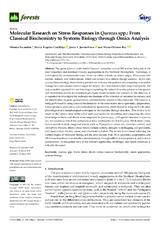Mostrar el registro sencillo del ítem
Molecular Research on Stress Responses in Quercus spp.: From Classical Biochemistry to Systems Biology through Omics Analysis
| dc.contributor.author | Escandón, Mónica | |
| dc.contributor.author | Castillejo-Sánchez, María A. | |
| dc.contributor.author | Jorrín-Novo, Jesús V. | |
| dc.contributor.author | Rey, María Dolores | |
| dc.date.accessioned | 2021-03-19T13:09:54Z | |
| dc.date.available | 2021-03-19T13:09:54Z | |
| dc.date.issued | 2021 | |
| dc.identifier.uri | http://hdl.handle.net/10396/21215 | |
| dc.description.abstract | The genus Quercus (oak), family Fagaceae, comprises around 500 species, being one of the most important and dominant woody angiosperms in the Northern Hemisphere. Nowadays, it is threatened by environmental cues, which are either of biotic or abiotic origin. This causes tree decline, dieback, and deforestation, which can worsen in a climate change scenario. In the 21st century, biotechnology should take a pivotal role in facing this problem and proposing sustainable management and conservation strategies for forests. As a non-domesticated, long-lived species, the only plausible approach for tree breeding is exploiting the natural diversity present in this species and the selection of elite, more resilient genotypes, based on molecular markers. In this direction, it is important to investigate the molecular mechanisms of the tolerance or resistance to stresses, and the identification of genes, gene products, and metabolites related to this phenotype. This research is being performed by using classical biochemistry or the most recent omics (genomics, epigenomics, transcriptomics, proteomics, and metabolomics) approaches, which should be integrated with other physiological and morphological techniques in the Systems Biology direction. This review is focused on the current state-of-the-art of such approaches for describing and integrating the latest knowledge on biotic and abiotic stress responses in Quercus spp., with special reference to Quercus ilex, the system on which the authors have been working for the last 15 years. While biotic stress factors mainly include fungi and insects such as Phytophthora cinnamomi, Cerambyx welensii, and Operophtera brumata, abiotic stress factors include salinity, drought, waterlogging, soil pollutants, cold, heat, carbon dioxide, ozone, and ultraviolet radiation. The review is structured following the Central Dogma of Molecular Biology and the omic cascade, from DNA (genomics, epigenomics, and DNA-based markers) to metabolites (metabolomics), through mRNA (transcriptomics) and proteins (proteomics). An integrated view of the different approaches, challenges, and future directions is critically discussed. | es_ES |
| dc.format.mimetype | application/pdf | es_ES |
| dc.language.iso | eng | es_ES |
| dc.publisher | MDPI | es_ES |
| dc.rights | https://creativecommons.org/licenses/by/4.0/ | es_ES |
| dc.source | Forests 12(3), 364 (2021) | es_ES |
| dc.subject | Quercus spp. | es_ES |
| dc.subject | Biotic stress | es_ES |
| dc.subject | Abiotic stress | es_ES |
| dc.subject | Classical biochemistry | es_ES |
| dc.subject | Omics approaches | es_ES |
| dc.subject | Systems biology | es_ES |
| dc.title | Molecular Research on Stress Responses in Quercus spp.: From Classical Biochemistry to Systems Biology through Omics Analysis | es_ES |
| dc.type | info:eu-repo/semantics/article | es_ES |
| dc.relation.publisherversion | http://dx.doi.org/10.3390/f12030364 | es_ES |
| dc.relation.projectID | Gobierno de España. PID2019-10908RB-100 | es_ES |
| dc.relation.projectID | Gobierno de España. FJCI-2017-31613 | es_ES |
| dc.relation.projectID | Gobierno de España. RYC-2017-23706 | es_ES |
| dc.relation.projectID | Gobierno de España. IJC2018-035272-I | es_ES |
| dc.rights.accessRights | info:eu-repo/semantics/openAccess | es_ES |

